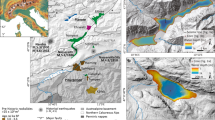Abstract
Based on detailed studies of paleoearthquakes along major active faults in the transition area between the northeastern margin of Tibetan Plateau and the Ordos block, this paper discusses temporal and spatial distribution of paleoearthquakes and their regional recurrent behavior. The regional paleoearthquake recurrence model in the area exhibits features of temporal and spatial clustering, which may be divided into two kinds. One has a time span about 300 years, and the other has about 1 000 years.
Similar content being viewed by others
References
Aki K. 1984. Asperities, barriers, characteristic earthquakes and strong motion prediction. J Geophys Res, 89: 5 867–5 872
Crone A J. 1987. Introduction to directions in paleoseismology. U. S. G. S. Open-File Report 87–673, 1–5
Ding G Y. 1992. Some problems related active fault segmentation. Earthquake Research in China, 8(2): 1–10 (in Chinese)
Deng Q D, Wang Y P, Liao Y H, et al. 1984. Colluvial wedges of fault scarps and active history of fault in Holocene along piedmont of Helanshan MT. Chinese Science Bulletin, 29(9): 557–560 (in Chinese)
Deng Q D, Xu X W, Yu G H. 1994. Characteristics of regionalization of active faults in China and their genesis. In: Professional Commission of Seismo-Geology, Seismological Society of China ed. Research on Active Fault in China. Beijing: Seismological Press, 1–14 (in Chinese)
Institute of Geology, China Seismological Bureau and Seismological Bureau of Ningxia Hui Autonomous Province. 1990. Haiyuan Active Fault. Beijing: Seismological Press, 234–245 (in Chinese)
Ma Z J, Chen Z L, Zhu Y Q, et al. 1984. The basic characteristics of the continental earthquakes, A Collection of Papers of International Symposium on continental Seismicity and Earthquake Prediction, 299–311
McCalpin J, Nishenko, S P. 1996. Holocene paleoseismicity, temporal clustering, and probabilities of future large (M>7) earthquakes on the Wasatch fault zone, Utah. Geophys Res, 101(B3): 6 233–6 253
Min W, Chai Z Z, Wang P, et al. 1993. Holocene paleoearthquakes research on fault of Luoshan MT. Plateau Earthquake, 5(4): 97–107 (in Chinese)
Min W, Wang P, Yang P, et al. 1994. Geometry pattern and Holocene slip rates along the eastern piedmont fault of the Luoshan MT. In: Editorial Committee on Active Fault Research eds. Research on Active Fault. Beijing: Seismological Press, 140–150 (in Chinese)
Nishenko S P, Buland R. 1987. A generic recurrence interval distribution for earthquake forecating. Bull Seism Sco Amer, 77: 1 383–1 399
Research Group on Active Faults Around the Ordos Block. 1988. The Active Fault System Around the Ordos Block. Beijing: Seismological Press, 258–269 (in Chinese)
Ran R, Duan R, Deng Q, et al. 1997. Paleoseismological studies by using three-dimensional trenches across the Haiyuan fault at Gaowenzi location. Geology and Seismology, 19: 28–39
Reid H F. 1911. The elastic-rebound theory of earthquakes. Univ Calif Publ Bull Dept of Geol, 6: 413–444
Savage J C, Cockerham R S. 1987. Quasi-periodic occurrence of earthquakes in the 1978–1986 Bishop-Mammoth Lakes sequence, eastern California. Bull Seism Soc Amer, 77(4): 1 347–1 358
Schwartz D P, Coppersmith K J. 1984. Fault behavior and characteristic earthquakes: Examples from the Wasatch and Anderson fault zones. J Geophys Res, 90: 5 681–5 698
Schwartz D P. 1995. Earthquake Repeatability: Magnitude, Timing, Segmentation, International School of Solid Earth Geophysics 11th Course: Active Faulting Studies for Seismic Hazard Assessment, Erice, Italy
Shimazaki K, Nakata T. 1980. Time-predictable recurrence model for large earthquakes. Geophys Res Lett, 7: 278–282
Sieh K E. 1978. Prehistoric large earthquakes produced by slip on San Andreas fault at Pallett Creek, California. J Geophys Res, 94: 3 907–3 939
Sieh K E. 1984. Lateral and revised dates of large prehistorical earthquakes at Pallett Creek, Southern California. J Geophys Res, 89: 7 641–7 670
Sieh K E, Stuiver M, Brillinger D. 1989. A more precise chronology of earthquakes produced by the San Andreas fault in southern California. J Geophys Res, 94: 603–623
Swan E H III, Schwar T Z, Cluff, et al. 1980. Recurrence of moderate to large magnitude earthquakes produced by surface faulting on the Wasatch fault zone. Utah Bull Seism Soc Am, 70: 1 431–1 462
Wallace R E. 1984. Patterns and timing of late Quaternary faulting in the Great Basin Province and relation to some regional tectonic features. J Geophys Res, 89: 5 763–5 769
Wallace R E. 1987. Variations in slip rates, migration, and grouping of slip events on faults in the Great Basin province. Bull Seism Soc Amer, 77: 868–876
Wang Y P, Song F M, Li Z Y, et al. 1990. Study on recurrence intervals of great earthquakes in the late quaternary of Xiangshan—Tianjingshan faults in Ningxia. Earthquake Research in China, 6(2): 15–24 (in Chinese)
Wesnousky S G, 1986. Earthquakes, quaternary faults, and seismic hazard in California. J Geophys Res, 91: 12 587–12 631
Yeats R S. 1995. Thin-Skinned vs Thick-Skinned Interpretation of Seismogenic Reverse Faults, International School of Solid Earth Geophysics 11th Course: Active Faulting Studies for Seismic Hazard Assessment, Erice, Italy
Zhang P Z. 1995. Application of Active Faulting Information to Seismic Hazard Assessment, International School of Solid Earth Geophysics 11th Course: Active Faulting Studies for Seismic Hazard Assessment, Erice, Italy
Author information
Authors and Affiliations
About this article
Cite this article
Min, W., Zhang, PZ. & Deng, QD. Primary study on regional paleoearthquake recurrence behavior. Acta Seimol. Sin. 13, 180–188 (2000). https://doi.org/10.1007/s11589-000-0008-9
Received:
Revised:
Accepted:
Issue Date:
DOI: https://doi.org/10.1007/s11589-000-0008-9




